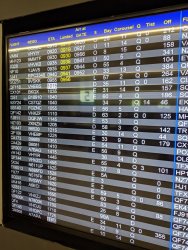Melburnian1
Veteran Member
- Joined
- Jun 7, 2013
- Posts
- 25,716
March and April are poor months to make comparisons with the same month of the previous year because Easter's date changes.
In 2018, Good Friday was on 30 March, so Easter passenger traffic would have been split to some extent between March and April.
In 2019, it was on 19 April, so that didn't occur.
Therefore a 'downturn' in reported passenger journeys in March 2019 compared to March 2018 may not be as serious as it otherwise might be.
That said, the latest BITRE figures disclose that March 2019, where overall international passenger traffic (arrivals and departures) dropped 2.5 per cent was the first month where this occurred since (coincidentally) March 2011.
Adelaide was the only international airport of any size to record a rise. (Port Hedland did too, but its numbers were insignificant, and Townsville no longer had international flights.) Canberra (down 21.1 per cent), Gold Coast (down 16.4 per cent), Cairns and (just) Perth all declined by more than five per cent, while Sydney dropped three per cent and Melbourne 2.5 per cent. Brisbane decreased 1.8 per cent.
Avalon handled just under 30,000 total passengers for March 2019, which at roughly 15,000 each way is around 500 per day inwards and the same outwards, indicating good load factors for its two scheduled A333s each day each way. That's twice as many international passengers as Darwin, which has a government presiding over a Territory economy that's in extremely poor shape.
If one is after two or three seats to spread oneself over, a good bet may be ID (Batik Air) on its PER - DPS as southbound its load factor was only 29.9 per cent in March 2019 while its northbound (to DPS) percentage of seats occupied was 28.7 per cent.
DZ (Donghai Airlines) SZX to DRW flights continue (as Mattg and I have separately previously highlghted) to be around the 30 per cent load factor as well, while much longer established Air Niugini's were about 50 per cent full in March 2019.
The number of passengers handled travelling to or from the USA rose 3.5 per cent in the year to March 2019. While this doesn't show the split between Australians visiting USA (or using it as a transit stop) and USA or other residents coming to Oz, it's a long way short of the media headlines that say tourism to USA is down. (Other statistics such as those from Visit USA - tourism body - may show that.)
Qantas' 'own metal' share of all March 2019 traffic rose 1.3 per cent to 18.2 per cent but the combined Emirates/Jetstar drop was 1.4 per cent.
OD's traffic was up 151.4 per cent while OZ rose 76 per cent and 5J more than 39 per cent, all as a result of new flights. This is why airports fight so hard to obtain new services (and governments, unwisely as we see above with the NT Donghai example, love to splash money around too.)
In 2018, Good Friday was on 30 March, so Easter passenger traffic would have been split to some extent between March and April.
In 2019, it was on 19 April, so that didn't occur.
Therefore a 'downturn' in reported passenger journeys in March 2019 compared to March 2018 may not be as serious as it otherwise might be.
That said, the latest BITRE figures disclose that March 2019, where overall international passenger traffic (arrivals and departures) dropped 2.5 per cent was the first month where this occurred since (coincidentally) March 2011.
Adelaide was the only international airport of any size to record a rise. (Port Hedland did too, but its numbers were insignificant, and Townsville no longer had international flights.) Canberra (down 21.1 per cent), Gold Coast (down 16.4 per cent), Cairns and (just) Perth all declined by more than five per cent, while Sydney dropped three per cent and Melbourne 2.5 per cent. Brisbane decreased 1.8 per cent.
Avalon handled just under 30,000 total passengers for March 2019, which at roughly 15,000 each way is around 500 per day inwards and the same outwards, indicating good load factors for its two scheduled A333s each day each way. That's twice as many international passengers as Darwin, which has a government presiding over a Territory economy that's in extremely poor shape.
If one is after two or three seats to spread oneself over, a good bet may be ID (Batik Air) on its PER - DPS as southbound its load factor was only 29.9 per cent in March 2019 while its northbound (to DPS) percentage of seats occupied was 28.7 per cent.
DZ (Donghai Airlines) SZX to DRW flights continue (as Mattg and I have separately previously highlghted) to be around the 30 per cent load factor as well, while much longer established Air Niugini's were about 50 per cent full in March 2019.
The number of passengers handled travelling to or from the USA rose 3.5 per cent in the year to March 2019. While this doesn't show the split between Australians visiting USA (or using it as a transit stop) and USA or other residents coming to Oz, it's a long way short of the media headlines that say tourism to USA is down. (Other statistics such as those from Visit USA - tourism body - may show that.)
Qantas' 'own metal' share of all March 2019 traffic rose 1.3 per cent to 18.2 per cent but the combined Emirates/Jetstar drop was 1.4 per cent.
OD's traffic was up 151.4 per cent while OZ rose 76 per cent and 5J more than 39 per cent, all as a result of new flights. This is why airports fight so hard to obtain new services (and governments, unwisely as we see above with the NT Donghai example, love to splash money around too.)
Last edited:


















